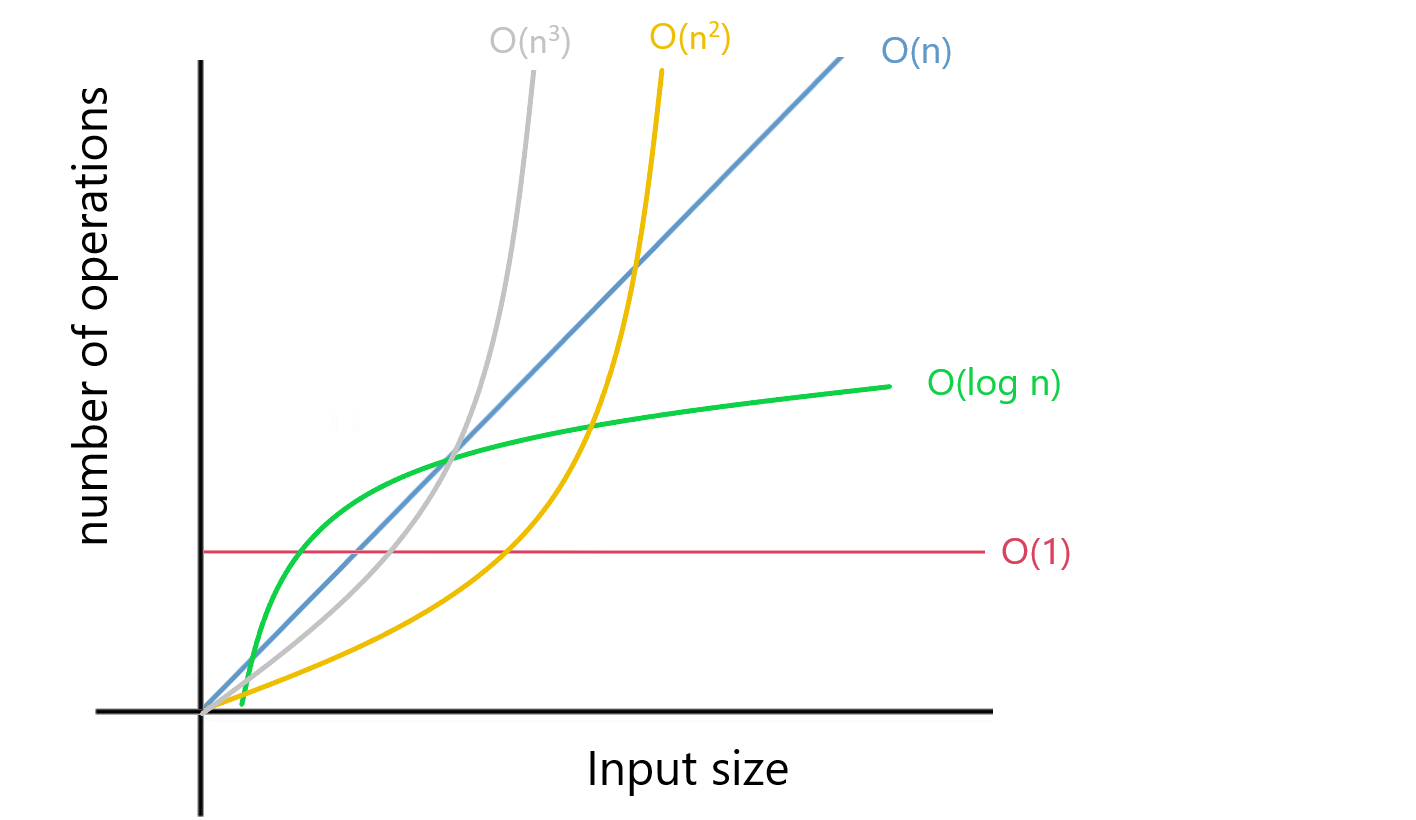Understanding Big O Notation
Data Structures and Algorithms in Python

Miriam Antona
Software Engineer
Big O Notation
- Measures the worst-case complexity of an algorithm
- Time complexity: time taken to run completely
- Space complexity: extra memory space
- Doesn't use seconds/bytes
- Different results depending on the hardware
- Mathematical expressions: $O(1)$, $O(n)$, $O(n^2)$...
Big O Notation

$O(1)$
colors = ['green', 'yellow', 'blue', 'pink']
def constant(colors):
print(colors[2])
constant(colors)
blue
$O(1)$
colors = ['green', 'yellow', 'blue', 'pink', 'black', 'white', 'purple', 'red']
def constant(colors):
print(colors[2]) # O(1)
constant(colors)
blue
$O(n)$
colors = ['green', 'yellow', 'blue', 'pink']
def linear(colors):
for color in colors:
print(color)
linear(colors)
greenyellowbluepink
$O(n)$
colors = ['green', 'yellow', 'blue', 'pink'] # n=4
def linear(colors):
for color in colors:
print(color) # O(4)
linear(colors)
n=4: 4 operations
$O(n)$
colors = ['green', 'yellow', 'blue', 'pink', 'black', 'white', 'purple'] # n=7
def linear(colors):
for color in colors:
print(color) # O(7)
linear(colors)
n=4: 4 operationsn=7: 7 operationsn=100: 100 operations- ...
- $O(n)$ complexity
$O(n^2)$
colors = ['green', 'yellow', 'blue']
def quadratic(colors):
for first in colors:
for second in colors:
print(first, second)
quadratic(colors)
n=3: (3 x 3) 9 operationsn=100: (100 x 100) 10,000 operations- quadratic pattern
- $O(n^2)$ complexity
green green
green yellow
green blue
yellow green
yellow yellow
yellow blue
blue green
blue yellow
blue blue
$O(n^3)$
colors = ['green', 'yellow', 'blue']
def cubic(colors):
for color1 in colors:
for color2 in colors:
for color3 in colors:
print(color1, color2, color3)
cubic(colors)
n=3: (3 x 3 x 3) 27 operationsn=10: (10 x 10 x 10) 1,000 operations- cubic pattern
- $O(n^3)$ complexity
Calculating Big O Notation
colors = ['green', 'yellow', 'blue', 'pink', 'black', 'white', 'purple']
other_colors = ['orange', 'brown']
def complex_algorithm(colors):
color_count = 0
for color in colors:
print(color)
color_count += 1
for other_color in other_colors:
print(other_color)
color_count += 1
print(color_count)
complex_algorithm(colors)
Calculating Big O Notation
colors = ['green', 'yellow', 'blue', 'pink', 'black', 'white', 'purple'] # O(1) other_colors = ['orange', 'brown'] # O(1)def complex_algorithm(colors): color_count = 0 # O(1)for color in colors: print(color) # O(n) color_count += 1 # O(n)for other_color in other_colors: print(other_color) # O(m) color_count += 1 # O(m)print(color_count) # O(1)complex_algorithm(colors) # O(4
Calculating Big O Notation
colors = ['green', 'yellow', 'blue', 'pink', 'black', 'white', 'purple'] # O(1)
other_colors = ['orange', 'brown'] # O(1)
def complex_algorithm(colors):
color_count = 0 # O(1)
for color in colors:
print(color) # O(n)
color_count += 1 # O(n)
for other_color in other_colors:
print(other_color) # O(m)
color_count += 1 # O(m)
print(color_count) # O(1)
complex_algorithm(colors) # O(4 + 2n
Calculating Big O Notation
colors = ['green', 'yellow', 'blue', 'pink', 'black', 'white', 'purple'] # O(1)
other_colors = ['orange', 'brown'] # O(1)
def complex_algorithm(colors):
color_count = 0 # O(1)
for color in colors:
print(color) # O(n)
color_count += 1 # O(n)
for other_color in other_colors:
print(other_color) # O(m)
color_count += 1 # O(m)
print(color_count) # O(1)
complex_algorithm(colors) # O(4 + 2n + 2m)
Simplifying Big O Notation
- Remove constants
- $O(4 + 2n + 2m)$ -> $O(n + m)$
- Different variables for different inputs
- $O(n + m)$
- Remove smaller terms
- $O(n + n^2)$
Simplifying Big O Notation
- Remove constants
- $O(4 + 2n + 2m)$ -> $O(n + m)$
- Different variables for different inputs
- $O(n + m)$
- Remove smaller terms
- $O(n + n^2)$ -> $O(n^2)$
Let's practice!
Data Structures and Algorithms in Python

